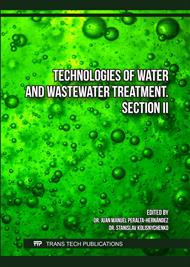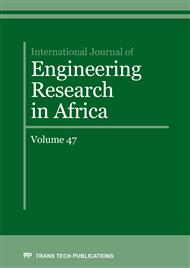[1]
J.Vymazal, Removal of Heavy Metals in a Horizontal Sub-Surface Flow Constructed Wetland,, Journal of Environmental Science and Health, vol. 40, p.37–41, (2005).
DOI: 10.1081/ese-200055858
Google Scholar
[2]
F. Morari, N. D. Ferro, and E. Cocco, Municipal Wastewater Treatment with Phragmites australis L . and Typha latifolia L . for Irrigation Reuse . Boron and Heavy Metals,, Water Air Soil Pollut, vol. 56, p.226–240, (2015).
DOI: 10.1007/s11270-015-2336-3
Google Scholar
[3]
X. Fan, B. Cui, Z. Zhang, and H. Zhang, Research for wetland network used to improve river water quality,, Procedia Environmental Sciences, vol. 13, no. 2011, p.2353–2361, (2012).
DOI: 10.1016/j.proenv.2012.01.224
Google Scholar
[4]
G. Bonanno, Comparative performance of trace element bioaccumulation and biomonitoring in the plant species Typha domingensis, Phragmites australis and Arundo donax,, Ecotoxicology and Environmental Safety, vol. 97, p.124–130, (2013).
DOI: 10.1016/j.ecoenv.2013.07.017
Google Scholar
[5]
E. Kalipci, Antimycobacterial activity of Populus alba leaf extracts,, Journal of Medicinal Plants Research, vol. 29, no. 5, p.6571–6577, (2011).
Google Scholar
[6]
H. I. Mustapha, J. J. A. van Bruggen, and P. N. L. Lens, Vertical subsurface flow constructed wetlands for polishing secondary Kaduna refinery wastewater in Nigeria,, Ecological Engineering, vol. 84, p.588–595, (2015).
DOI: 10.1016/j.ecoleng.2015.09.060
Google Scholar
[7]
X. Wang, X. Bai, J. Qiu, and B. Wang, Municipal wastewater treatment with pond-constructed wetland system: A case study,, Water Science and Technology, vol. 51, no. 12, p.325–329, (2005).
DOI: 10.2166/wst.2005.0491
Google Scholar
[8]
S. Lu, L. Pei, and X. Bai, Study on method of domestic wastewater treatment through new-type multi-layer artificial wetland,, International Journal of Hydrogen Energy, vol. 40, p.11207–11214, (2015).
DOI: 10.1016/j.ijhydene.2015.05.165
Google Scholar
[9]
A. Gross, O. Shmueli, Z. Ronen, and E. Raveh, Recycled vertical flow constructed wetland (RVFCW)-a novel method of recycling greywater for irrigation in small communities and households,, Chemosphere, vol. 66, no. 5, p.916–923, (2007).
DOI: 10.1016/j.chemosphere.2006.06.006
Google Scholar
[10]
H. R. Hadad, M. M. Mufarrege, M. Pinciroli, G. A. Di Luca, and M. A. Maine, Morphological Response of Typha domingensis to an Industrial Effluent Containing Heavy Metals in a Constructed Wetland,, vol. 58, p.666–675, (2010).
DOI: 10.1007/s00244-009-9454-0
Google Scholar
[11]
V. Gagnon, F. Chazarenc, M. Kõiv, and J. Brisson, Effect of plant species on water quality at the outlet of a sludge treatment wetland,, Water Research, vol. 46, no. 16, p.5305–5315, (2012).
DOI: 10.1016/j.watres.2012.07.007
Google Scholar
[12]
M. Li, Q. Zhou, M. Tao, Y. Wang, L. Jiang, and Z. Wu, Comparative study of microbial community structure in different filter media of constructed wetland,, Journal of Environmental Sciences, vol. 22, no. 1, p.127–133, (2010).
DOI: 10.1016/s1001-0742(09)60083-8
Google Scholar
[13]
S. G. Abdelhakeem, S.A. Aboulroos, and M.M. Kamel, Performance of a vertical subsurface flow constructed wetland under different operational conditions,, Journal of Advanced Research, vol. 7, no. 5, p.803–814, (2016).
DOI: 10.1016/j.jare.2015.12.002
Google Scholar
[14]
Q. Xu, S. Chen, Z. Huang, L. Cui, and X. Wang, Evaluation of Organic Matter Removal Efficiency and Microbial Enzyme Activity in Vertical-Flow Constructed Wetland Systems,, Environments, vol. 3, no. 4, p.26–35, (2016).
DOI: 10.3390/environments3040026
Google Scholar
[15]
C. Todorovics, T. M. Garay, and Z. Bratek, The use of the reed (Phragmites australis) in wastewater treatment on constructed wetlands,, Acta Biologica Szegediensis, vol. 49, no. 1–2, p.81–83, (2005).
Google Scholar
[16]
B.C. A. Hadad, H.R., Maine M.A., Macrophyte growth in a pilot-scale constructed wetland for industrial wastewater treatment,, Chemosphere, vol. 63, p.1744–1753, (2006).
DOI: 10.1016/j.chemosphere.2005.09.014
Google Scholar
[17]
K. Yahiaoui, A. Zoubeidi, N. Rouahna, and A. Ouakouak, Research Article,, Journal of Fundamental and Applied Sciences, vol. 10, no. 2, p.265–276, (2018).
Google Scholar
[18]
N. M. O. (NMO), Average Daily of Preci- pitation and Temperature 1989-2015,, El Oued, Algeria, (2016).
Google Scholar
[19]
M. Achak, N. Ouazzani, and L. Mandi, Élimination Des Polluants Organiques Des Effluents De L'Industrie Oléicole Par Combinaison D'Un Filtre À Sable Et Un Lit Planté," Revue des sciences de l,eau, vol. 24, no. 1, p.35, (2011).
DOI: 10.7202/045826ar
Google Scholar
[20]
J. Rodier, B. Legube, and N. Merlet, Analyse de l'eau Rodier. 9ème edition, 9th editio. Paris, (2009).
Google Scholar
[21]
H. H. Zhang et al., Removal of phosphorus and nitrogen from domestic wastewater using a mineralized refuse-based bioreactor,, Environmental Technology, vol. 33, no. 2, p.173–181, (2012).
DOI: 10.1080/09593330.2011.555420
Google Scholar
[22]
Y.P. Katsenovich, A. Hummel-batista, A.J. Ravinet, and J.F. Miller, Performance evaluation of constructed wetlands in a tropical region,, Ecological Engineering journal, vol. 35, p.1529–1537, (2009).
DOI: 10.1016/j.ecoleng.2009.07.003
Google Scholar
[23]
R.R. Ranjani K., Kneidinger CH., Treatment of maize processing industry wastewater by constructed wetlands,, in 5th International conférence on wetlands Systems for water pollution control, 1996, p. 9p.
Google Scholar
[24]
R. A. Smith, R. B. Alexander, and M. G. Wolman, Analysis and Interpretation of Water-Quality Trends in Major U.S. Rivers, 1974-81.,, (1987).
Google Scholar
[25]
A. Jedicke, B. Furch, U. Saint-Paul, and U. B. Schlüter, Increase in the oxygen concentration in Amazon waters resulting from the root exudation of two notorious water plants, Eichhornia crassipes (Pontederiaceae) and Pistia stratiotes (Araceae),, Amazoniana, vol. 11, no. 1, p.53–69, (1989).
Google Scholar
[26]
C.C. Tanner, J.S. Clayton, and M.P. Upsdell, Effect of loading rate and planting on treatment of dairy farm wastewaters in constructed wetlands-I. Removal of oxygen demand, suspended solids and faecal coliforms,, Water Research, vol. 29, no. 1, p.17–26, (1995).
DOI: 10.1016/0043-1354(94)00139-x
Google Scholar
[27]
S. Saxena, Parameters Evaluation of Municipal Waste Water After Treatment Using Sub Surface Flow Constructed Wetland in Ekant Park Bhopal,, International Journal of Research - GRANTHAALAYAH, vol. 4, no. 12, p.24–30, (2016).
DOI: 10.29121/granthaalayah.v4.i12.2016.2388
Google Scholar
[28]
A.S. Juwarkar, B. Oke, A. Juwarkar, and S. M. Patnaik, Domestic wastewater treatment through constructed wetland in India,, Water Science and Technology, vol. 32, no. 3, p.291–294, (1995).
DOI: 10.2166/wst.1995.0151
Google Scholar
[29]
S. Tiglyene and L.M.A.E. Jaouad, Removal of chromium from tannery wastewater by vertical infiltration reed beds,, Rev. Sci. Eau, vol. 18, no. 2, p.177–198, (2005).
Google Scholar
[30]
L. Cui, Y. Ouyang, Y. Chen, X. Zhu, and W. Zhu, Removal of total nitrogen by Cyperus alternifolius from wastewaters in simulated vertical-flow constructed wetlands,, vol. 35, p.1271–1274, (2009).
DOI: 10.1016/j.ecoleng.2009.05.017
Google Scholar
[31]
S. Ayaz, Ö. Aktas, N. Fındık, L. Akc, and C. Kınacı, Effect of recirculation on nitrogen removal in a hybrid constructed wetland system,, vol. 40, p.1–5, (2012).
DOI: 10.1016/j.ecoleng.2011.12.028
Google Scholar
[32]
S. Lavrova and B. Koumanova, Nutrients and Organic Matter Removal in a Vertical-Flow Constructed Wetland,, Applied Bioremediation - Active and Passive Approaches, p.69–99, (2013).
DOI: 10.5772/56245
Google Scholar
[33]
D. Kurniadie, Wastewater Treatment Using Vertical Subsurface Flow Constructed Wetland in Indonesia,, American Journal of Environmental Sciences, vol. 7, no. 1, p.15–19, (2011).
DOI: 10.3844/ajessp.2011.15.19
Google Scholar
[34]
A. Panrare, P. Sohsalam, and T. Tondee, Constructed Wetland for Sewage Treatment and Thermal Transfer Reduction, vol. 79, no. November 2015. Elsevier B.V., (2015).
DOI: 10.1016/j.egypro.2015.11.535
Google Scholar
[35]
K. Bahlo, Naturnahe Abwasserreinigung: their Development. In: Constructed Wetlands in Planung und Bau von Pflanzenkläranlagen, 5th Edn. Ökobuch, Kassel, (2005).
Google Scholar
[36]
C. C. Tanner, J. S. Clayton, and M. P. Upsdell, EFFECT OF LOADING RATE A N D PLANTING ON TREATMENT OF DAIRY FARM WASTEWATERS IN CONSTRUCTED WETLANDS--II . REMOVAL OF NITROGEN A N D PHOSPHORUS,, vol. 29, no. I, p.27–34, (1995).
DOI: 10.1016/0043-1354(94)00140-3
Google Scholar
[37]
P.F. Breen, A mass balance method for assessing the potential of artificial wetlands for wastewater treatment,, Wat. Res., vol. 24, no. 6, p.689–697, (1990).
DOI: 10.1016/0043-1354(90)90024-z
Google Scholar
[38]
V. Gagnon and G. Maltais-landry, Treatment of Hydroponics Wastewater Using Constructed Wetlands in Winter Treatment of Hydroponics Wastewater Using Constructed Wetlands in Winter Conditions,, Water Air Soil Pollut, vol. 212, no. 1, p.483–490, (2010).
DOI: 10.1007/s11270-010-0362-8
Google Scholar



